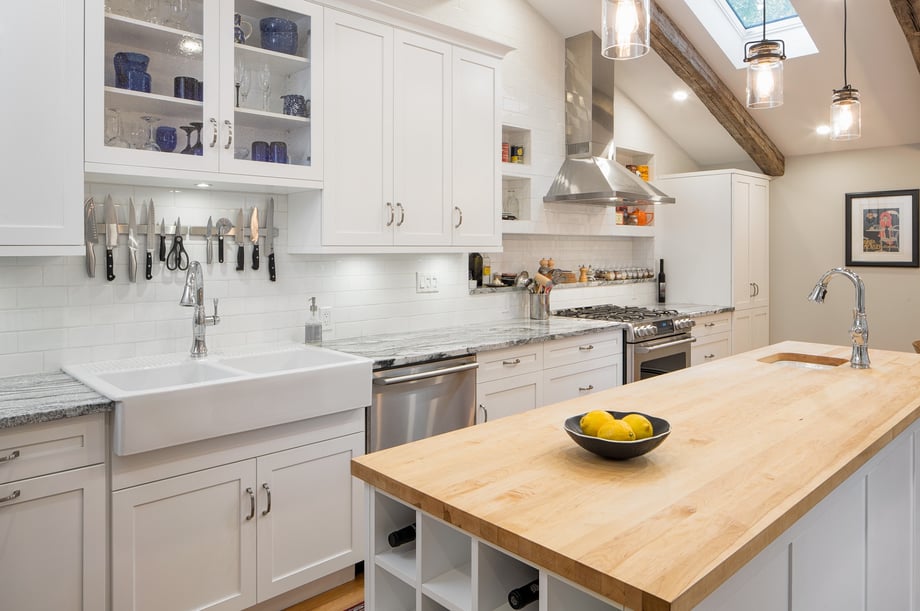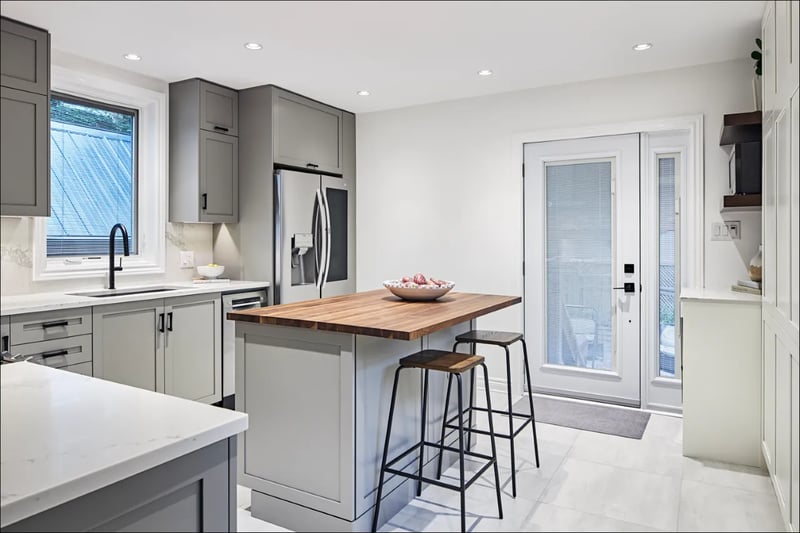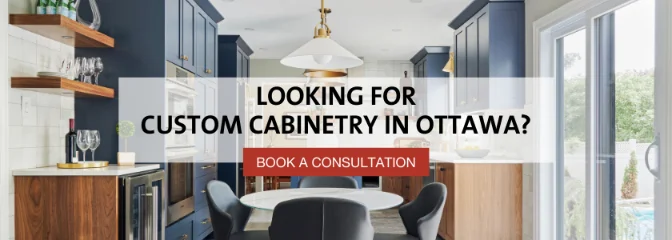6/01/2023 • Blog, Comparisons, Design Tips
Popular Woods for Butcher Block Kitchen Countertops
Estimated Read Time: 6 Minutes
Butcher-block countertops are perhaps a lesser-known option in kitchen design, but you shouldn’t let that deter you. Wooden countertops bring a neutral, earthy vibe to homes and are particularly great for cottagey, rustic aesthetics like a farmhouse-style kitchen.
But how do you know what wood species works best?
At Deslaurier, we specialize in all things custom cabinets and kitchen design. While we don’t sell butcher-block countertops, we’ve crafted numerous kitchen designs and custom accent units that have been accentuated by the use of butcher-block surfaces.
With that, this article will tell you everything you need to know about butcher block countertops and offer 4 exampled of the most popular woods you can use for your kitchen surfaces.
Let’s get started!
|
Table of Contents |
What are Butcher Block Countertops
Butcher block kitchen countertops are thick wood surfaces that can be made in a variety of different styles and used for kitchen countertops, bartops, wall units, and anywhere else that requires a surface.
They are manufactured by gluing multiple sheets of natural solid wood or wood veneer together to create a compact, thick countertop.
Even more, butcher block countertops can produce some of the most remarkable kitchen countertops you’ve ever seen!
Not to mention, the wood goes with anything. Homeowners often mix and match wood and natural stone counters for a best-of-both-worlds result in their kitchen design.
Take a look below at a beautiful butcher block island countertop paired with white quartz perimeter surfaces:

With that, let’s take a look at some of the most popular wood species you can use for butcher-block countertops.
1. Hard Maple
It should be noted that there are two distinct types of maple: hard and soft maple.
The differences between these two categories are major, so it’s crucial we clarify which we’re talking about. As is the same with maple kitchen cabinets, butcher-block countertops will only be made using hard maple.
Hard maple, as its name might suggest, is simply far stronger and more durable. Qualities that are highly valued when considering a kitchen work surface.
Through the use of a measurement called the Janka Hardness Scale. The results of the test are straightforward: the higher the number on the scale, the harder and more resistant to dents or scratches the wood is.
Hard maple registers at a highly respectable 1450, while soft maple sits roughly around 950. That’s a big discrepancy and a clear indicator why hard maple is the preferred choice for anything from flooring and cabinets to wooden kitchen surfaces.
If you plan on implementing butcher-block countertops as your main kitchen work surface, you’d be hard-pressed to find a better – and more readily available – option than hard maple.
2. Oak
Oak is another fantastic species for wood countertops.
But really, what isn’t oak great for?
Oak is a strong and solid wood – with a 1300 Janka score – with high resiliency and is resistant to moisture. It’s one of best building materials out there, utilized for flooring, cabinets, desks, furniture, and even exterior uses like decks and boats!
Oak wood is noted for having light to middle brown colouring with a cast of reddish hues, complemented by a prominent, fairly straight grain pattern.
The beauty of oak’s prominent grain combined with the strong, durable qualities of the wood makes it a go-to choice for butcher-block surfaces.
3. Walnut
Walnut is a stunning natural wood noted for its significant colour and strong, typically straight grain variation. Though its grain is very open and slightly more coarse than the smoothness of cherry, walnut still has a beautiful, uniform surface.
Walnut can range anywhere from a light brown to a deep, dark chocolate hue. In addition, it also has a unique aging process. With time, the dark brown colour of walnut naturally begins to lighten.
Walnut is a luxurious wood species that sits at the higher end of pricing spectrum.
Take a look at this beautiful black walnut countertop from one of our kitchen designs:

4. Bamboo
And finally, one of the more exotic “woods” on this list: Bamboo.
For starters, bamboo is actually a type of grass, not a wood species! Don’t let that designation fool you, as bamboo’s strength and durability surpass some of the hardest woods available like maple and oak.
Bamboo grass is highly sustainable, replenishes quickly (they can grow as much as 30 inches in one day!), and makes for an exceptionally strong and durable building material.
Along with its recognized strength, bamboo is also naturally resistant to water and mildew. Making it an ideal material to implement for your kitchen surfaces, where spills and splashes are prone to happen.
Having said all that, there is no strength or quality grading system for bamboo, which makes it very important that you do your research and properly vet your manufacturer or supplier before purchasing bamboo products for your kitchen.
Types of Butcher Block Grain Patterns
The customization of butcher block countertops doesn’t stop at just the different wood species you can use. After you pick the perfect wood, you have to decide on which grain pattern best suits your visual preferences.
With their unique construction method, butcher block countertops allow you to spark your artistic side by selecting four unique wood grain patterns: End-Grain, Edge-Grain, Face-Grain, and Blended.
Each style will offer distinctive characteristics ranging from appearance, strength, and cost.
End-Grain
End-grain surfaces are noted for their “checkerboard”-esque appearance. They’re created by combining pieces of wood vertically, allowing the ends to be on full display.
End-grain is the most expensive method of construction due to how many individual pieces of wood are being used, as well as the additional glues and resins needed to combine the materials into a single countertop.
Thanks to their compact construction, end-grain surfaces are also the strongest and most durable butcher block countertop method available.
Edge-Grain
Edge-grain is the most affordable option, made by attaching straight cuts of wood parallel to one another with their edges exposed. Thanks to this, they create strong and stable countertop slabs.
Unlike end-grain, an added bonus of edge (and face) grain surfaces is that they can be made joint-free (lengthwise), depending on the size of the countertop.
Face-Grain
Face-grain, or “wide plank” countertops, are created by using wide, flat boards of wood.
These countertops are less practical for a high-performance surface – they’re more susceptible to stains, dents, and scratches – but they undoubtedly offer the most stylish and aesthetically pleasing appearance of the four methods.
Due to their lack of durability, combined with their visual flair, face-grain butcher-block countertops are best used as accent surfaces not intended for functional, daily use.
Blended
Blended butcher block countertops are manufactured by finger-jointing different lengths of wood together.
Blended surfaces offer a less consistent appearance than edge or face-grain styles, but can combine different species and colours of wood into one congruent slab for its own unique aesthetic.
Use Reclaimed Wood!
You might not know this, but butcher-block is actually one of the most eco-friendly materials you can use for your kitchen countertops!
Depending on the manufacturer, butcher-block countertops can be created solely using reclaimed wood and local materials.
Reclaimed wood is processed wood that has been retrieved from its original application and harvested for new uses. Think old barns, decks, factories, and other buildings.
It’s a phenomenal way to salvage old lumber and utilize them for a new function. In this case: butcher-block kitchen countertops.
If you’re looking for a blended grain pattern, there’s no better way to achieve that than by using salvaged wood. A variety of different reclaimed woods can be paired together to create some truly unique looking blended butcher-block surfaces.
Discover Deslaurier Custom Cabinets
If you’re looking to pair custom cabinetry with the perfect butcher-block kitchen countertop, Deslaurier Custom Cabinets has everything you need.
With over 40 years of experience to our name, we provide our clients with a fully customized design process with our talented team of designers. Book a consultation for a one-on-one with a Deslaurier kitchen expert virtually or in-person at our Ottawa showroom!
Interested in becoming an authorized Deslaurier dealer? Visit our Become a Dealer page to learn more! Live outside the area? Find a Dealer to connect with a Deslaurier dealer near you!



